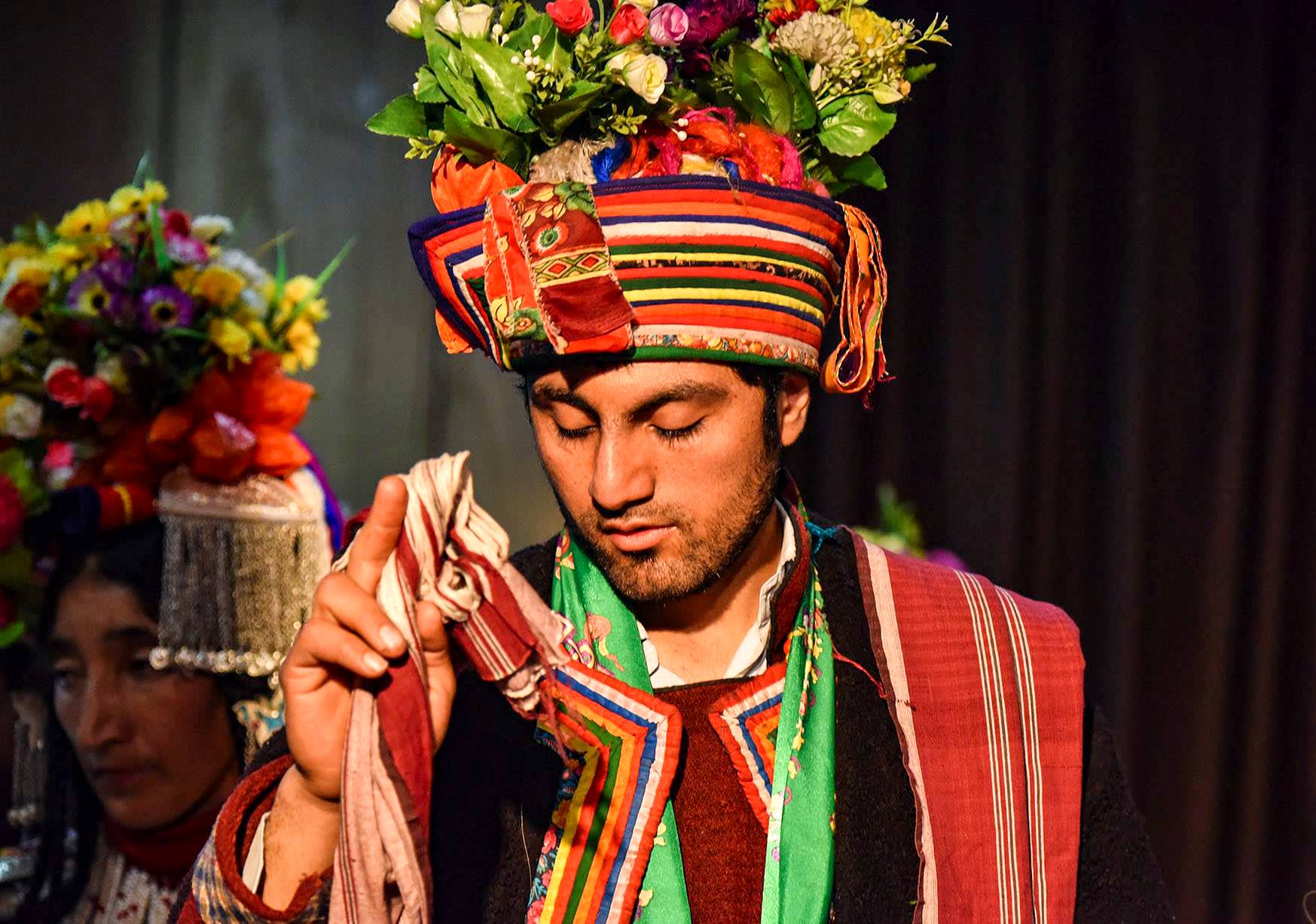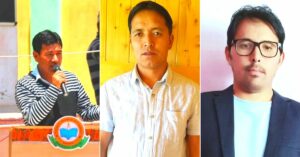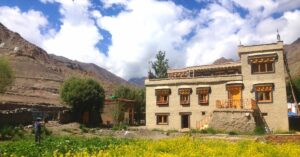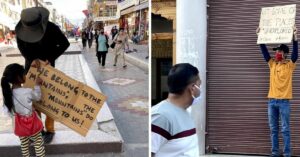What Connects Ladakh’s Dard Aryans to Alexander the Great? The Answer Will Fascinate You!
With just under 4000 of them left in the world, they have long been famous for their distinctive tall and sharp physical features. A unique history of a unique people.

Nearly 200 km from Leh, on either side of the Indus River, are the villages of Dha, Hanu, Garkon and Darchik.
Put together; they comprise what is popularly known across tourism circles as the “Aryan Valley”—homes to the unique Buddhist Dard tribes, whose members are known across the region as Brokpas.
With just under 4000 of them left in the world, the Brokpas have long been exoticised as the “last pure specimens” of the Aryan race, thanks to their height and sharp physical features (blue eyes).
Some believe they are direct descendants of soldiers of Alexander the Great’s army which stayed back in the region nearly 2,000 years ago, while local folklore suggests that they migrated from Gilgit in Pakistan-Occupied Kashmir.
The ‘Aryan’ Claim
Although DNA testing presents a picture of an ancient and isolated community, there is little evidence to suggest where they really came from.
Many anthropologists dispute the Aryan claim, suggesting that this description is a legacy of British Orientalist scholars who were deeply invested in the practice of racial categorisation.
Speaking to Open Magazine, Mona Bhan, an anthropologist who has long studied this community, says that this perception of them being the last Aryans is quite flawed.
“They based it on an ill-conceived framework that conflated racial frameworks of identity with the region’s ‘distinctive’ linguistic features. Since certain languages spoken in the Northwestern Himalayas were thought to share similarities with other Indo-Aryan languages, the speakers of these languages were also categorised as Aryans,” says Bhan.
The Dardic languages are a sub-group of the Indo-Aryan languages natively spoken in northern Pakistan’s Gilgit Baltistan and Khyber Pakhtunkhwa, Jammu and Kashmir, and eastern Afghanistan. The Dards speak a distinct dialect of Dard-Shina, which is also known among the people of Ladakh as Brokskat. They have no script.
Speaking to The Better India, Virendra Bangroo, an Assistant Professor at the Indira Gandhi National Centre for the Arts (IGNCA), says “the word ‘Dard’ itself comes from ‘Daradas,’ which roughly translates into people who live on the hillsides.”
Bangroo states that the people of this ethnic community are also linguistically and culturally different from those living in other parts of Ladakh.
“A Brokpa tribal is identified by a colorful headgear called Tepi that has various colorful props attached, embellished with colorful berry flowers. The Tepi, they believe, wards off the evil eye. The women wear heavy metal, gold and silver jewellery along with full length sheep skin capes and sheep wool pherans. Old metal coins are part of the accessory. The men mostly wear maroon gowns with cummerbunds.There is a belief that metal worn on the body prevents sickness,” writes Nazir Ladakhi.
“We had no medical facilities in the past, so each prop on the head gear has some medicinal purpose. The seven colored ribbon wards any ailment caused by the Sun or eclipse. The silver brooches ward off planetary influences, the peacock feather wards off paralysis,” says a teacher in Darchik.

Religion, Lifestyle and Culture
Having converted to Buddhism nearly two centuries ago, the Dards largely follow the Drigung Kagyu lineage of Mahayana Buddhism.
Some members of the community, particularly those on the other side of the Line of Control, are primarily Shia Muslims. However, they still follow their original customs of worshipping rivers, trees and mountains and practice a form of animism—a tradition which, according to some, goes back 5,000 years.
For sustenance, Brokpas practice animal husbandry, rearing sheep and goats for their milk and meat. Religious taboos prevent them from touching poultry or dairy-sourced items.
Their traditional diet revolves around meat (primarily mutton, although only during festivals and depending on the economic position of the household), tsampa (roasted flour, usually barley flour and sometimes also wheat flour), potatoes, radishes, turnips and butter tea.
Unlike the rest of Ladakh, these four villages are situated in the Batalik Sector, an isolated green belt of Ladakh, which allows them to grow certain crops.
The region is famous for its delicious apricots. Earlier, the Brokpas would barter apricots for salt, but today, they sell the fruit for anywhere between Rs 400–1000 per kilogram. They even extract its seed and oil, as it fetches them a good price in markets across the state.
They have long maintained their unique culture thanks to a long-standing practice of endogamy.
Marriages outside the community aren’t looked upon very favourably. Until recently, households practiced a form of polyandry where the groom pays a bride price, while women have rights of divorce.
The Future of The Community
With Dard men migrating to other parts of the region in search of employment and marrying women from outside the community, their attempts at maintaining their gene pool are under threat.
“There is no doubt that the community is finding a hard time to maintain a balance between modernity and tradition. Migration and modernisation pose a real threat to their culture, although the community thus far has done a remarkable job in maintaining it,” says Bangroo.
Local politics and geopolitical realities are also posing a threat to the community’s survival.
“Unfortunately, this linguistic-cultural group of the Brokpas was divided when Ladakh was fragmented into Leh and Kargil districts in 1978. While Garkon and Darchik now fall under Kargil district, Dah and Hanu come under Leh,” says Bangroo.
Not falling entirely on either side of the administrative divide has made it hard for the community to consolidate their political influence, leaving them without requisite representation—a necessary tool to protect their unique cultural heritage.
Brokpa shepherds have long protected our borders, offering intelligence inputs on enemy movements from across the Line of Control.
However, events like the Kargil War, for example, have also hampered development efforts in these parts. To visit certain parts, you still require inner line permits.
Also Read: How an IAS Initiative Is Weaving Pashmina’s Profits Back to Ladakhi Women
Thus, it comes as no surprise that a delegation of 30 members from the community recently submitted a charter of demands to Sudarshan Bhagat, the Minister of State for Tribal Affairs, seeking greater economic opportunities within the region and protecting their unique culture, as reported by The Indian Express.
The Brokpas have, for a long time, managed to preserve their culture and remain isolated from the rest of the world.
However, change, the one constant, has already broken down the doors, bringing in modernity, which does pose a real risk to their culture. While the community is doing its part, state support must be forthcoming to facilitate this maintenance of heritage.
(Edited by Gayatri Mishra)
Like this story? Or have something to share? Write to us: [email protected], or connect with us on Facebook and Twitter.
This story made me
- 97
- 121
- 89
- 167
Tell Us More
We bring stories straight from the heart of India, to inspire millions and create a wave of impact. Our positive movement is growing bigger everyday, and we would love for you to join it.
Please contribute whatever you can, every little penny helps our team in bringing you more stories that support dreams and spread hope.



















